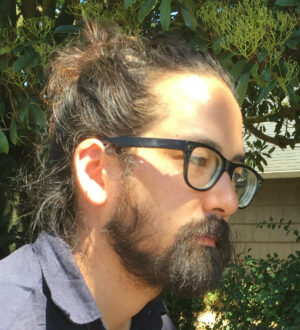The Poet’s Nightstand
The Poet’s Nightstand with Brandon Shimoda

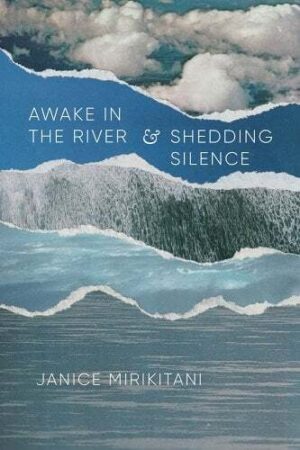
Awake in the River & Shedding Silence
Janice Mirikitani
A year before Janice Mirikitani died, I wrote her an email. I introduced myself, told her how much her work meant to me. She was one of the first Japanese American poets I read, one of the first I had even heard of, which meant, and continues to mean, the illumination of my existence. There was Mitsuye Yamada, Lawson Inada, and Janice Mirikitani, all of whom I discovered, both belatedly and right on time, in the basement of the library at the University of Montana, where I was working towards my MFA in poetry, writing poems about JA incarceration, about my grandfather’s experience as an “enemy alien.” All three poets were incarcerated when they were young and wrote about it: Yamada as a teenager in Minidoka, Inada as a child in Jerome and Amache, Mirikitani as an infant in Rohwer. She emailed back. “It is gratifying to hear that my work has had some positive effect,” she wrote. “It is always a writer’s hope that the work extends through generations.” It was two days to Christmas. We made plans to talk on the phone, but it kept getting pushed back. Public events, holidays, the pandemic. But it never happened. I regret it terribly. Recently, my friend Nancy Ukai sent me an audio recording of an interview she did with Mirikitani not long before she died. “My mother lost her teeth,” Mirikitani says, in the interview, “because she was nursing me as a baby in camp. In the camps, there was no calcium. So, I depleted her of calcium.” She goes on to talk about how it was impossible, after camp, to be seen by a white dentist. Her mother, Shigemi, appears throughout her poetry, including in one of my favorites poems, “Desert Flowers,” in which Mirikitani addresses her mother directly: “Your tears, mama, / have nourished us.” To read these lines in the wake of her mother losing her teeth, in the light of the poet reckoning, tearfully, with that fact... In “Breaking Silence,” Mirikitani quotes from her mother’s testimony before the Commission on Wartime Relocation and Internment, in 1981—Shigemi’s plaintive, straightforward voice woven throughout her daughter’s tender-tough, tough-tender poem. The first lines: “There are miracles that happen / she said. / From the silences...” The final line: “Our language is beautiful.” It took Shigemi forty years—it took the fight for redress and reparations—to talk openly about camp, a silence a poet understands and gives space to while acknowledging the reasons for that silence with their own uninhibited speech. “Our bodies were loud / with yellow screaming flesh / needing to be silenced / behind barbed wire.” Mirikitani’s work is sharp, mournfully, tirelessly urgent. She addresses anti-Asian racism, transgenerational trauma and healing, solidarity, redemption. In her social justice work too, which was boundless (see: glide.org; see also: Eunsong Kim’s recent essay in American Poets about Mirikitani’s collaboration with June Jordan on the Poetry for the People workshop at Glide, San Francisco.) Awake in the River & Shedding Silence include Mirikitani’s first two books of poetry, 1978, 1987 and are the perfect introduction to her work, everyone should get it.
Purchase

Migritude
Shailja Patel
Kaya Press is one of the greatest literary publishers on earth. Their catalog and community of authors are dreams. So many of their books feel like they could only exist in a dream, then I wake up to discover they’re real! A book of writings by documentary filmmaker Kazuo Hara, for example; if it didn’t exist, I would fantasize it existing, I still do. A two-volume history of global mixed-race identities of persons of Japanese descent?! An anthology of writings on the role of religion in the Japanese American concentration camps?! Kaya’s catalog includes a translation, by the incredible Rajiv Mohabir, of songs by Lalbihari Sharma, an indentured servant on a plantation in British Guyana; a collection of Denise Uyehara’s performance pieces; an anthology of South Korean science fiction; and two of my favorite books, Q.M. Zhang’s Accomplice to Memory and Amarnath Ravva’s American Canyon, among so many many many. Another brilliant, beyond comparison book is Shailja Patel’s Migritude. I recently found a used copy in the basement of Left Bank in St. Louis. It was shelved in an unexpected section, I don’t remember which, because it could have been shelved, legitimately, anywhere. The back cover says Nonfiction, Poetry, Performance, African Studies, South Asian Studies. I read Migritude years ago at the Poetry Center in Tucson. I used to sit in their luxurious chairs, read several books at once, write down the page numbers where I stopped, return a week later, pick up where I left off, and so on. I read Migritude that way. Now I’m reading it again. I love reading books for a second (or further) time because I love the experience of returning to an experience that might only be half-remembered, foggily at that, and realizing, the second (or further) time, what the experience was, or is; like folding a memory back so it touches and reanimates the original experience. Migritude is a dream because it contains all of the elements that make books, for me, the ultimate technology: dreams, poems, letters, observations harvested (Patel’s words), close readings of transcendently meaningful objects (in the case of Migritude, eighteen saris, which Patel’s mother collected and was saving for Patel when she married), questions accumulating and uplifting like the rungs of a ladder, descriptions of posters and paintings on the walls of our parents’ dining rooms, transcripts of self-determination, rage. So I make this work from rage, Patel writes. All work (books especially) made from rage should be able to fit in one’s pocket, because work made from rage needs to be portable, easily accessed, so it can be put to use at any moment, anywhere. I just checked and, yes, Migritude fits in my back pants pocket exactly. Rage motivates and manifests so many registers. The migrant, as she motivates and manifests, accumulates and makes use of the most extraordinary texture of forms. I love how Migritude, the book, incorporates, into itself, an examination of Migritude, the performance, including its genesis, its personal and political histories, a timeline, and interviews, at the end of the book, with Patel. Self and soul-determination require self-reflection, self-reflection requires the smartest positioning and articulation of mirrors, mirrors require grinding, polishing; living is unending rehearsal. I also love this sentence, on page 77: “I walk a lot of my writing, the way you walk a dog—it completes itself in motion.”
Purchase
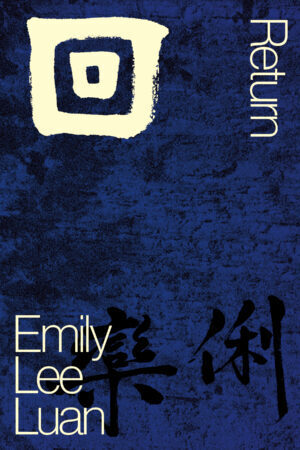
回 / Return
Emily Lee Luan
There are an infinite number of things to say about Emily Lee Luan’s virtuosic 回 / Return, which is related, in part, to one of the traditions by which it is inspired: huiwenshi, the Chinese reversible poem: a poem that can be read forwards and backwards, sometimes in many directions at once. According to Michèle Métail’s Wild Geese Returning—which Luan cites at the end of 回 / Return—the earliest known reversible poem dates back to the 2nd century. The most famous is Su Hui’s Xuanjitu (4th century), sometimes translated as The Map of the Armillary Sphere, and consists of 840 characters embroidered, in five colors, into a grid. It can be read, the book says, “as many as 12,000 ways.” Su Hui made it for her husband, Dou Tao, who was in exile. One of the most exciting—transfixing, complex—reversible poems is Luan’s I can’t go back. It appears on page 72 of 回 / Return. I don’t know if Luan considers it, strictly speaking, a reversible poem, but its relationship to infinity feels certain and secure. I have been staring at it for months. How can I explain it? It consists of five columnar elements that... no, you have to get 回 / Return
and see for yourself! There is no way to explain it without making it disappear. Reversible poems are informed, inherently, by distance. “They make distance and space perceptible,” writes Métail (translated from the French by Jody Gladding). They are informed, inherently, by separation and distance; by missing, mourning, melancholy; by migration, exile; by the desire to return; by the impossibility of returning; by the disappearance of the past in the simultaneously centrifugal and centripetal force of the present. I guess there is something of that in the shape, the shapes, of I can’t go back. Reversibility suggests endlessness, interminability. I read with Luan at City Lights this summer. She read When My Sorrow Was Born (p. 6), which also appeared in Best American Poetry (2021). She also read the poems about her grandfather on pages 47-52, each one with the same reversible title. In them, Luan and her grandfather spend time together, visit places together, eat together (steamed trout, fried pork and rice), climb a pagoda together, a mountain, look at things together, a green field, the old family well. I just remembered that Luan said something, during our conversation after the reading, about the well, its importance in her life—her memory, her poetry. Now that I think about it, maybe that is the beginning of how I might describe I can’t go back: the family well. “We stand around it,” Luan writes, “but we don’t peer in, and there is a silence—like watching the ocean fold from behind glass—between us. Sometimes it feels like different phases of the same sadness...” The relationships we share with the ones we love, including ourselves, are so strikingly clear, so encompassing, and yet, within the texture of time and loss and unending movement, so painfully irretrievable.
Purchase
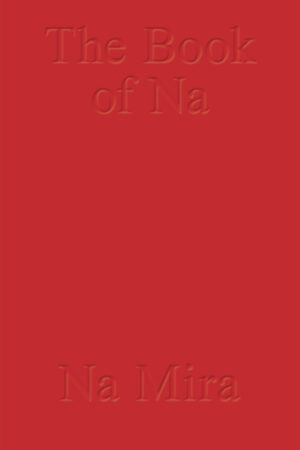
The Book of Na
Na Mira
My friend, the poet Farid Matuk, told me about The Book of Na. We were on a Zoom date, it was night, we were talking about fathers, our fathers. Farid was sitting next to a window. I could see, out his window, the giant saguaro in his yard. I remember that saguaro. Farid and I used to live in the same city (Tucson; he still does); our families spent a lot of time together, especially during the pandemic. I could see, beyond the saguaro, people walking through the neighborhood. Farid asked if I knew the artist Na Mira, or her book, The Book of Na. She had recently had a show at the Museum of Contemporary Art. Farid was invited to read at the opening. The invitation was to read page 44 of a book of his choosing. (He read page 44 of Dot Devota’s PMS: A Journal in Verse.) The exhibition was called Subrosa. The work was in dialogue with the work of Theresa Hak Kyung Cha, including Cha’s unfinished film, White Dust From Magnolia. The Book of Na, Farid said, was also in dialogue with Cha’s work. “It’s beautiful,” he said. Everything that Farid has recommended to me I have pursued and loved, he’s always right. I ordered The Book of Na. When it arrived, the envelope was empty. I wrote to the publishers, Wendy’s Subway. They sent another copy. I imagined that the person who had the first copy, if anyone—by chance or they took it—was undergoing an existential transformation. When the second copy arrived, infinite thanks to Wendy’s Subway, it felt like a homecoming. Imagine a homecoming stretching the span of the relationship between a book and its reader like a meditation filmed in open shutter panorama projected onto the walls of the house one constructs to capture the feeling of meeting oneself in another. The Book of Na contains, like Shailja Patel’s Migritude, so many of the elements that make it the ultimate technology, in this case also: handwriting, film stills, timestamped prose, shamanism, I-Ching, the wisdom of Turiyasangitananda (Alice Coltrane), and, as mentioned, a dialogue with the work of Theresa Hak Kyung Cha. Cha and her work are very important to me—her book Dictee is, for me, the ultimate example of the ultimate technology—and I am always trying to learn about her work through the work of artists and writers who are also always trying to learn about it. Na Mira’s The Book of Na is exemplary in this way, because it is a dialogue; it adds to the energy Cha was generating, sending into the future, on diasporic memory, forgetting, dis/placement, dis/integration. Also, it’s printed on red paper. There is a foolish, ultimately futile question I occasionally indulge in, which is: whose work is the true descendant of the work of Theresa Hak Kyung Cha?
Purchase
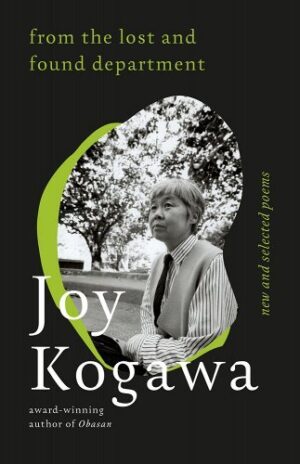
From the Lost and Found Department: New and Selected Poems
Joy Kogawa
I’ve read From the Lost and Found Department six times this year, and it’s not even out yet. It’s Joy Kogawa’s first book of poetry in twenty years. The last was A Garden of Anchors (2003). My copy of A Garden of Anchors is inscribed by Kogawa. Not to me (it’s a used copy), but to a woman named Mimi Divinsky. “Any (human) friend of Chris is a friend of mine,” Kogawa wrote, to Mimi. I don’t know Mimi. I just looked her up. She was a doctor, activist, pioneer in narrative medicine. She died in 2007. (Who is Chris? Why only human friends?) Anyway, the reason I’ve read From the Lost and Found Department six times is that, disclaimer, I wrote the introduction. The book’s editor, the profoundly brilliant Canisia Lubrin, invited me to write it. A surprising invitation. An intimidating task. I reread all of Kogawa’s books, then read From the Lost and Found Department six times. It’s like I had to do one thousand hours of homework to write a single sentence about Kogawa and her poetry, even though it was already in me. Sometimes research and/or one thousand hours is the way back to oneself. Research as reintroduction. From the Lost and Found Department is over 300 pages and includes poems from all of her books: The Splintered Moon, A Choice of Dreams, Jericho Road, Woman in the Woods, A Garden of Anchors. The new poems are filled with tributes to people, portraits, appreciations, which feels, because they are the newest poems, to be a putting of life in order. They also remind me of Keorapetse Kgositsile’s poems for people; they supports the existence of others. A Choice of Dreams has been especially meaningful to me because it includes a series of poems documenting Kogawa’s first visit to Japan. In the first poem, Ancestor’s Graves in Kurakawa (which also appears in From the Lost and Found Department), she travels from Canada to the “high hillside grave” of her ancestors on Shikoku. “Grey and green ferns hang down / Edging my faint beginnings with shades,” she writes. Kurakawa is across the Inland Sea from Kurahashi, where my grandfather was born, and where, one hundred years later, I visited. There was a small graveyard there too, and grey and green ferns hanging over the gravestones. “The hiddenness stretches beyond my reach,” Kogawa writes, in a line that echoes, is echoed by, the opening of her novel, Obasan. “If I could follow the stream down and down to the hidden voice,” she writes, “would I come at least to the freeing word?” Kogawa’s body of work is as an attempt, compassionate and merciful, improvisatory and precise, to reach and to realize—or to reach, if not realize—what is hidden; to perceive that what is hidden is hidden; to perceive that what is hidden has been hid; to write the self into an answer. What is the freeing word? Not the word itself but what is it? And what happens when one gets there? Even though that was the prose, Obasan, the poetry is the whole revelation of the stream. Joy Kogawa’s From the Lost and Found Department comes out in November.
Purchase

